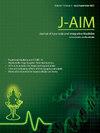Panchakarma治疗疼痛性创伤后三叉神经病变1例
IF 1.9
Q3 INTEGRATIVE & COMPLEMENTARY MEDICINE
引用次数: 0
摘要
三叉神经痛(TN)的特征是由无害刺激引起的突然的电击样疼痛。创伤后三叉神经病变(PTTN)是创伤性三叉神经病变的一个子集,具有这些特征,但也涉及感觉异常和心理困扰。传统的治疗方法,包括药物治疗和外科手术,往往提供有限的缓解,并有其局限性。阿育吠陀为长期治疗提供了更全面、非侵入性的选择。本病例研究详细介绍了一位45岁男性患者,右侧面部疼痛持续8个月,对常规药物无反应。基线疼痛强度在数值评定量表(NRS)上为6分(满分为10分)。干预措施包括Virechana(治疗性净化)、Ksheera-bashpa Swedana(治疗性药奶蒸汽)、Nasya(通过鼻腔给药)、Shirodhara(治疗性头部流)和Matra Basti(一种润滑灌肠),随后是7个月的疗程。在治疗过程中,疼痛强度从NRS的6分逐渐降低到1分,伴随着情绪健康、睡眠和整体生活质量的显著改善。随访评估证实了持续的益处,包括减少对传统药物的依赖。这个案例突出了阿育吠陀在PTTN管理中的潜力。为了更好地了解这种管理方法,需要更多的案例报告和此类系列。本文章由计算机程序翻译,如有差异,请以英文原文为准。
Panchakarma treatment for painful Post-Traumatic Trigeminal Neuropathy – A case report
Trigeminal Neuralgia (TN) is characterized by sudden, electric shock-like pain triggered by innocuous stimuli. Post-Traumatic Trigeminal Neuropathy (PTTN), a traumatic subset of TN, shares these features but also involves sensory abnormalities and psychological distress. Conventional treatments, including medications and surgical interventions, often provide limited relief and have their limitations. Ayurveda offers a more holistic, non-invasive alternative for long-term management. This case study details a 45-year-old male patient with right-sided facial pain persisting for eight months, unresponsive to conventional medications. Baseline pain intensity was six out of ten on the Numerical Rating Scale (NRS). The interventions comprised Virechana (therapeutic purgation), Ksheera-bashpa Swedana (therapeutic steam of medicated milk), Nasya (medication through nasal route), Shirodhara (therapeutic streaming over head), and Matra Basti (a form of unctuous enema), followed by a seven-month course of medications. During the course of treatment, pain intensity gradually reduced from six to one on the NRS, accompanied by significant improvements in emotional well-being, sleep, and overall quality of life. Follow-up assessments confirmed sustained benefits, including a decreased dependence on conventional medication. This case highlights the potential of Ayurveda in PTTN management. More case reports and series of this kind are desirable for a better insight into this management approach.
求助全文
通过发布文献求助,成功后即可免费获取论文全文。
去求助
来源期刊

Journal of Ayurveda and Integrative Medicine
INTEGRATIVE & COMPLEMENTARY MEDICINE-
CiteScore
4.70
自引率
12.50%
发文量
136
审稿时长
30 weeks
 求助内容:
求助内容: 应助结果提醒方式:
应助结果提醒方式:


